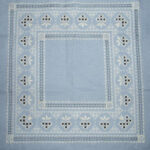A member of the nettle family, ramie is used like hemp in the production of ropes, sacks and utilitarian cloth. Ramie is finer than hemp, however, and more versatile. The fibers of high-quality ramie are silky, with a high sheen and creamy white color. (Reference)
Most fibers are no thicker than a human hair and easily broken. Workers half a century ago pulled them out with the teeth rather than by hand, in order to avoid damage to the threads. Modern machines have virtually eliminated this practice. (Reference)
Noticeable differences may be seen between high quality ramie and cheaper fabrics. The weave of the better-quality fabrics is tighter, with a softer hand (feel). The silky sheen is also more noticeable. (Reference)
Advantages of Ramie
High-quality ramie exhibits many desirable qualities. Its absorbs water and dries out more quickly than other fabrics. It’s brilliance is unsurpassed among similar fabrics such as flax, hemp or jute. The fact that it is three times stronger than hemp increases its value for home decor and clothing. (Reference)
Ramie is resistant to insects and bacteria. Since it dries rapidly, mildew is not a problem. Like silk, its strength increases when dampened, and it absorbs dye readily. High water temperatures do not affect it, and repeated laundering only enhances its luster and softness. (Reference)
Disadvantages
Even the highest quality ramie has shortcomings that create a challenge for decorators and manufacturers. Ramie lacks resiliency and elasticity. Variations in color from yard to yard prove undesirable in certain applications. Without the use of softening agents, fabrics made with ramie may be brittle and stiff. Pure ramie fabrics need ironing, since they wrinkle easily. Care must be taken to avoid creasing in order to prevent breakage of the individual fibers. (Reference)
Ramie Blends
Blends of cotton, wool or other fabrics eliminate some problems. A fabric made of cotton and ramie, for example, will provide luster and strength while minimizing fiber breakage. When blending ramie with wool, ramie adds breathability to the fabric and decreases the possibility of shrinkage, while wool contributes a softer hand. Adding ramie to rayon will serve to counteract rayon’s tendency to rip when wet. (Reference)
Considerations
Ramie must be chosen with its ultimate purpose in mind. Cotton blends are best for fabrics that will withstand a good deal of folding and creasing. For wall coverings, pure ramie may be used in low-traffic areas, where there is little chance for abrasions. Ramie blends will hold up to frequent dryer tumbles better than pure fabrics. For home design accessories such as draperies, a blend may perform better due to ramie’s tendency to fade in direct sunlight. (Reference)
References
University of California at San Diego: Ancient Cloth
Nebraska Cooperative Extension: NebFact-Ramie
US Department of Agriculture: Ramie Fiber Production
Palomar Community College: Plant Fibers






